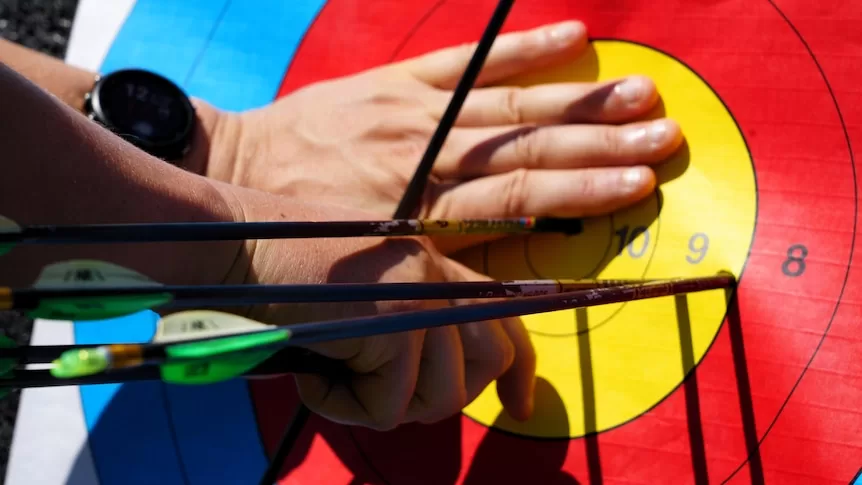When Ameera Lee signed her young son up to try archery several years ago, the last thing she expected was to fall in love with the sport.
Para-archery
- It involves athletes with a physical or vision impairment, and has both standing and seated events.
- Archers shoot at a target from a distance of 70 metres with a compound or recurve bow.
- There are three classifications in Para-archery — W1, Open and vision impairment.
- Only the first two classifications are included in competition at the Paralympics.
That love has now taken the single mum to the edge of qualifying for the Paris Paralympics.
“All the hard work and all the effort and all the tears and all the pain and all the joys, it’s finally coming to fruition,” Lee said.
And her now 15-year-old son could not be prouder.
“He’s so supportive; after a while I was a bit tired (from the sport) and I wanted to have a break… he encouraged me to continue,” Lee said.
It’s been a rapid rise in the sport for the 50-year-old who lives with multiple sclerosis.
Lee made her international debut on the European circuit in Italy in 2018, reaching the quarter finals in her category.
In 2021 she won the Australian Open, competing against both para and non-disabled competitors, making her the first Para-archer to win.
“There’s no handicap, there’s no differential, everyone is on the same line shooting the same distances,” Lee said.
“It was the best that I have shot and I keep using that as my benchmark competition.”
Continuing to push
It hasn’t been an easy Paralympic journey for Lee, who missed selection for the Tokyo Paralympics after being knocked out of a qualification match.
“It wasn’t the end of the story for me, I wanted to keep continuing to push myself, to make myself better,” Lee said.
It’s been a balancing act for the archer, who is not only a single parent, but also works full-time.
Lee must also handle her symptoms of MS, which can be impacted by extreme heat, affecting her motor skills and balance — training during a hot Sydney summer can be problematic.
Handling her heat intolerance includes using ice packs, air-conditioned rooms and drinking cold drinks.
“I’ve learned to manage how my body reacts and how to calm my nervous system,” she said.
“You find ways to work around to be your best performance.”
Selection isn’t a given
Para-archery is open to any athlete with a physical disability or vision impairment and includes both standing and wheelchair events.
When Lee first started archery, she would compete standing up, but in recent years, due to her MS, she has started using her wheelchair.
“The actual sport and the execution in sport is very similar in terms of the distances and the equipment that disabled and non-disabled people use,” NSW Institute of Sport senior archery coordinator Mark Wilson said.
The aim of the sport is to shoot arrows at a target, from a distance of 70 metres.
Athletes can use a recurve bow or a compound bow, which is what Lee uses.
The compound bow includes mechanical pulleys, telescopic sights and release aids to assist with accuracy.
There are three different classifications in Para-archery: W1, Open and vision impairment.
Only W1 and Open are contested at the Paralympics, with W1 for athletes with the most significant impairment.
Lee competes in the Open category.
Mr Wilson said Australia is hoping to send one of its biggest archery teams yet to the Paris Games.
Lee earned a quota spot for Australia last year, a spot she still needs to gain selection for.
“Her next steps in April are big, which is the Paralympic trial process on home turf,” Mr Wilson said.
Lee will know by the end of the month if all the hard work has paid off and she has made the team.
Beyond the range
It isn’t just the Paralympics that archery has brought Lee, it has impacted her life beyond the range.
For Lee it is important to share her story with her community, through school visits and those living with MS.
“I enjoy speaking to people and encouraging people to be authentic, to be their best selves… everyone has something to gain,” she said.
It is this authentic self that Lee brings to not only her life, but also her sport, and she hopes that she can encourage others who are older or live with disability to try something new.
“I have a saying — be creative, get inspired and never give up,” she said.
“I came up with that in a place and a time that things weren’t going so great for me, and I was thinking I can’t stay in this state, I have to keep moving forward.”
“Archery is the start of all of this, it is what opened opportunities for me.”
Sports content to make you think… or allow you not to. A newsletter delivered each Saturday.
